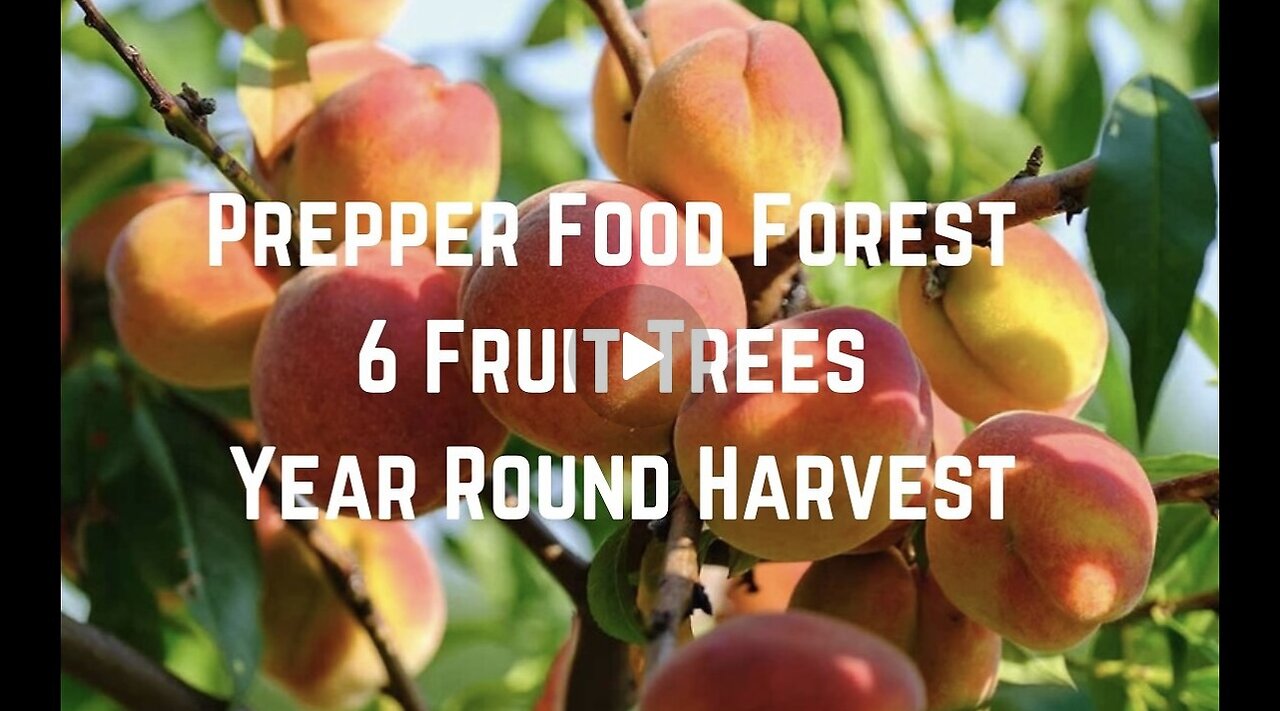Premium Only Content

Prepper Food Forest: 6 Fruit Trees Year Round Harvest
Food Forest & Perennials
A food forest or forest garden is a low-maintenance, plant and tree based food production system. It is intended to mimic the woodland ecosystem and patterns found in nature. The goal is to cultivate a sustainable food source, with an emphasis on perennial vegetables, fruits, nuts, and herbs, to reduce the need for annual replanting. A prepper must take into account the camouflage factor.
For a prepper, a food forest can augment ones primary stored food supply located at ones bug out location or residence. It is advantageous to have planted a food forest before a collapse of society. If the plants are spaced out far enough, they can blend in with the natural environment for the camouflage factor.
A perennial is a plant that comes back year after year. This differentiates it from annuals, which must be planted each year, and biennials, which only live for two years. Just plant your garden or orchard once, and your plantings should last for several years, maybe even several decades.
While all plants listed below are perennials, they may not grow perennially in all locations. In your local climate, plants that come back year after year may not be able to survive over a more extreme winter or summer. Research and check for compatibility with your region before you buy anything by referring to the USDA hardiness zones listed on the seed or plant's label.
Perennial Vegetables
Artichoke (Try Jerusalem, also known as Sunchokes.)
Arugula (Type Specific), Asparagus (Keep the bed weed-free, and they'll produce for 20 years or more. You can take your first harvest in the third growing season.) Broccoli (Not all varieties are perennial. Try varieties Nine Star or Purple Cape.) Collard (Type Specific), Dandelion, Kale (Type Specific), Lovage, Onion (Try potato onions, shallots, Egyptian onions, Japanese bunching onions, Welsh onions, and Chinese leeks.), Radicchio, Rhubarb, Sorrel, Spinach (Not all varieties are perennial. Try varieties Ceylon, Sissoo, or New Zealand.) Sweet Potato, Tree Cabbage, Tree Collard, Watercress, Wasabi, Yacon, Yam.
Perennial Fruits
Apple, Asian Pear, Apricot, Avocado, Banana, Blackberry, Blueberry, Cherry, Coconut, Currant, Date, Fig, Goji Berry, Gooseberry, Grape, Guava, Honeyberry, Huckleberry, Jujube, Kiwi, Kumquat, Lemon (Must be brought indoors in the winter in colder climates.) Lime, Loquat, Mango, Mulberry, Nectarine, Olive, Orange (Must be brought indoors in the winter in colder climates.), Papaya, Paw Paw, Peach, Pear, Persimmon, Plum, Pomegranate, Raspberry, Strawberry (Replant every three years to maintain vigor and cut down on disease.)
Perennial Nuts
Almond, Chestnut, Hazelnut, Macadamia, Pecan, Pistachio, Walnut.
Perennial Herbs
Basil (Not all basil is perennial. Try African Blue or East Indian for a perennial variety.), Cardamom, Chamomile, Chia (Seeds Food Source), Chives, Echinacea, Fennel, Garlic, Ginger, Green Tea, Horseradish, Lavender (It often takes several seasons to establish.) Lemon Balm, Mint, Oregano, Parsley, Rosemary (It can be difficult to grow in some zones.) Sage, Thyme, Turmeric.
Survival Prepper Information Guide PDF
https://acrobat.adobe.com/id/urn:aaid:sc:VA6C2:68f4ed0e-5460-41a6-b926-30290b9cd218
-
 LIVE
LIVE
DynastyXL
7 hours ago🔴LIVE: Fortnite The Comeback Stream Starts Here🎃
138 watching -
 LIVE
LIVE
BrightGaming
1 hour agoDragon Warrior 1 (NES): Defeat the DragonLord & Save the Kingdom as Erdrick's Heir with BrightGaming
960 watching -
 19:15
19:15
Stephen Gardner
18 hours ago🟢YES! Trump did it! + Elon Musk DROPS BOMBSHELL on Democrat Party!
110K210 -
 29:24
29:24
Afshin Rattansi's Going Underground
1 day agoEx-CIA Advisor & Afshin Rattansi Have HEATED Exchange Over Ukraine Proxy War
3.21K32 -
 1:06:17
1:06:17
Mike Rowe
20 hours agoThe Mastermind Behind THIS Radical Idea At WSU Tech | Sheree Utash #448 | The Way I Heard It
93.6K17 -
 1:29:13
1:29:13
I_Came_With_Fire_Podcast
13 hours agoAncient Egypt's Tech & the Secret Temples of Malta
17.2K2 -
 LIVE
LIVE
GritsGG
3 hours agoWin Streaking! Most Wins 3499+ 🧠
119 watching -
 DVR
DVR
Bannons War Room
6 months agoWarRoom Live
34.1M8K -
 LIVE
LIVE
ttvglamourx
3 hours ago $1.01 earnedPLAYING WITH VIEWERS !DISCORD
104 watching -
 1:21:38
1:21:38
VapinGamers
3 hours ago $1.95 earnedTools of the Trade - EP04 Of Thumbnails and Titles, What's Important? - !rumbot !music
23.5K1